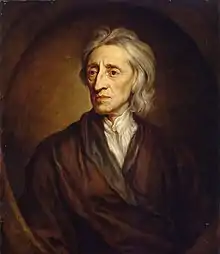Associationism
Associationism is the idea that mental processes operate by the association of one mental state with its successor states.[1] It holds that all mental processes are made up of discrete psychological elements and their combinations, which are believed to be made up of sensations or simple feelings.[2] In philosophy, this idea is viewed as the outcome of empiricism and sensationism.[3] The concept encompasses a psychological theory as well as comprehensive philosophical foundation, and scientific methodology.[2]
History
Early history
The idea is first recorded in Plato and Aristotle, especially with regard to the succession of memories. Particularly, the model is traced back to the Aristotelian notion that human memory encompasses all mental phenomena and was discussed in detail in the philosopher's work, Memory and Reminiscence.[4] This view was widely embraced until the emergence of British associationism, which began with Thomas Hobbes.[4]

Associationist School
Members of the Associationist School, including John Locke, David Hume, David Hartley, Joseph Priestley, James Mill, John Stuart Mill, Alexander Bain, and Ivan Pavlov, asserted that the principle applied to all or most mental processes.[5]
John Locke
The phrase association of ideas was first used by John Locke. In chapter 33 his An Essay concerning Human understanding titled “Of the Association of Ideas’ he describes the ways that ideas can be connected to each other.[6] He writes “Some of our ideas have a natural correspondence and connexion one with another”.[7] Although he believed that some associations were natural and justified, he believed that others were illogical caused errors in judgment. He further explains that one can associate some ideas together based on their education and culture. “there is another connection of ideas wholly owing to chance or custom”.[6][7] The term associationism later became more prominent in psychology and the psychologists that used that subscribed to the idea became known as the associationists.[6] Locke's view that the mind and body are two aspects of the same unified phenomenon can be traced back to Aristotle's ideas on the subject.[8]
David Hume
In his book Treatise on Human Nature David Hume outlines three principles for ideas to be connected to each other, resemblance, continuity in time or place, and cause or effect.[9] He argues that the mind uses these principles to go from one idea into another rather than reason.[6] He writes “When the mind, therefore, passes from the idea or impression of one object to the idea or belief of another, it is not determined by reason, but by certain principles, which associate together the ideas of these objects, and unite them in the imagination.”[9] These connections are formed in the mind by observation and experience. Hume does not believe that any of these associations are “necessary’ in a sense that ideas or object are truly connected, instead he sees them as mental tools used for thinking.[6]
Later members
Later members of the school developed very specific principles elaborating how associations worked and even a physiological mechanism bearing no resemblance to modern neurophysiology.[10] For a fuller explanation of the intellectual history of associationism and the "Associationist School", see Association of Ideas.
Applications
Associationism is often concerned with middle-level to higher-level mental processes such as learning.[8] For instance, the thesis, antithesis, and synthesis are linked in one's mind through repetition so that they become inextricably associated with one another.[8] Among the earliest experiments that tested the applications of associationism involve Hermann Ebbinghaus' work. He was considered the first experimenter to apply the associationist principles systematically and used himself as subject to study and quantify the relationship between rehearsal and recollection of material.[8]
Some of the ideas of the Associationist School also anticipated the principles of conditioning and its use in behavioral psychology.[5] Both classical conditioning and operant conditioning use positive and negative associations as means of conditioning.[10]
Karatani's theory
Kojin Karatani, a Japanese philosopher, refers to Hannah Arendt's remark about council communism (Soviet or Räte) that it does not emerge as a result of tradition or theory of revolutions, but "entirely spontaneously, each time as if it had never existed before", and that such a social construct is the same as what has been called socialism, communism, anarchism, etc., but because these names are cloying and misleading, he calls it X or associationism in his book.
References
- Perler, Dominik (2015). The Faculties: A History. Oxford: Oxford University Press. p. 256. ISBN 9780199935253.
- Bailey, Richard (2018-02-06). Education in the Open Society - Karl Popper and Schooling. Routledge. ISBN 9781351726481.
- Banerjee, J.C. (1994). Encyclopaedic Dictionary of Psychological Terms. New Delhi: M.D. Publications Pvt. Ltd. p. 19. ISBN 818588028X.
- Anderson, John R.; Bower, G. H. (2014). Human Associative Memory. New York: Psychology Press. p. 16. ISBN 9781317769880.
- Boring, E. G. (1950) "A History of Experimental Psychology" New York, Appleton-Century-Crofts
- Howard C. Warren (1921). A History Of The Association Psychology. Universal Digital Library. Charles Scribner's Sons.
- Locke, John. (2000). Essay Concerning Human Understanding, An. Infomotions, Inc. OCLC 927360872.
- Sternberg, Robert (1999). The Nature of Cognition. Cambridge, MA: MIT Press. p. 69. ISBN 9780262692120.
- Hume, David (1739-01-01), Nidditch, P. H; Selby-Bigge, Sir Lewis Amherst (eds.), "A Treatise of Human Nature", David Hume: A Treatise of Human Nature (Second Edition), Oxford University Press, doi:10.1093/oseo/instance.00046221, ISBN 978-0-19-824587-2
- Pavlov, I.P. (1927, 1960) "Conditioned Reflexes" New York, Oxford (1927) Dover (1960)
External links
- Pre-History of Cognitive Science.
- Howard C. Warren (1921). A History Of The Association Psychology. Charles Scribner's Sons. Retrieved 2010-02-10.